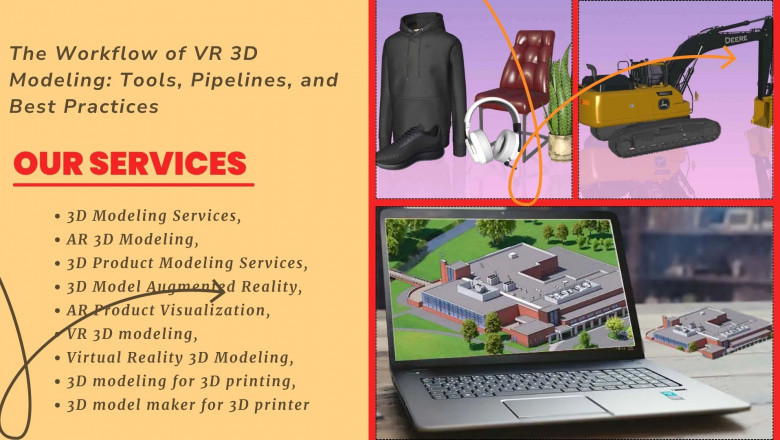views
Workflow of VR 3D Modeling: Tools
At the core of this immersive experience lies VR 3D Modeling—a specialized process of creating three-dimensional assets optimized for virtual spaces. As the demand for Virtual Reality 3D Modeling grows across industries like gaming, healthcare, e-commerce, and education, understanding the right tools, pipelines, and best practices becomes essential for 3D artists and businesses alike.
Whether you're a freelance designer or a company offering 3D Modeling Services, mastering the VR modeling workflow is key to producing high-performance, visually compelling models. Let’s break down the essentials.
Understanding VR 3D Modeling: A Quick Overview
Professionals often work alongside AR 3D Modeling and 3D product modeling services, as many assets are reused across both augmented and virtual reality platforms. For instance, a 3D Model Augmented Reality experience might also be ported into VR for enhanced interactivity.
Step-by-Step Workflow for VR 3D Modeling
1. Concept Design and Planning
Artists gather references, sketch ideas, and determine the scope of the 3D model—be it a character, product, building, or full environment. This stage defines the artistic vision and technical constraints, such as polygon limits and performance metrics for VR.
Businesses offering 3D Modeling Services usually create design briefs based on the client's vision, platform (Meta Quest, HTC Vive, etc.), and usage (gameplay, simulation, training, etc.).
2. Modeling the Asset
Artists use tools like:
-
Maya/3ds Max – Preferred in professional pipelines for high-poly modeling.
-
ZBrush – Great for organic sculpting and intricate details.
-
SketchUp – Often used in architecture and real estate for VR walk-throughs.
Whether creating characters or objects, this stage focuses on defining the shape and volume. For assets designed for 3D product modeling services, accuracy and proportion are crucial.
This is also where assets for 3D Modeling for 3D Printing might branch off. Although designed digitally, models intended for 3D printing need to be manifold and watertight—qualities not always necessary for VR.
3. Retopology and Optimization
VR systems rely on real-time rendering. Hence, high-poly models must undergo retopology, reducing polygon count while maintaining shape. This process ensures that the models are lightweight and efficient for VR engines.
Game engines like Unity or Unreal Engine have strict draw call and frame rate requirements. That’s why experienced 3D Model Maker for 3D Printer professionals often adapt their techniques to meet performance constraints in VR, despite coming from a different specialization.
4. UV Unwrapping and Texturing
Tools such as:
-
Substance Painter-/
-
Adobe Photoshop
-
Quixel Mixer
They are used for painting and baking textures. Artists often employ physically based rendering (PBR) workflows to ensure materials behave realistically under VR lighting.
When working on AR Product Visualization, consistent and high-resolution textures are critical, as users often examine models up close. These same standards apply to VR 3D Modeling, where immersion depends heavily on realism.
5. Rigging and Animation (if needed)
If the VR model requires movement, like characters or machinery, then rigging is added using bones and controllers. This is common in interactive VR games or simulations.
Animation tools like Maya, Blender, or Mixamo help bring the asset to life. For example, a robot created for a training simulation may require realistic movement to aid in user learning.
6. Lighting and Scene Composition
VR engines like Unity and Unreal offer tools for real-time lighting optimization.
Scene composition ensures that assets are placed logically and support the narrative or functional goal. This is especially important in Virtual Reality 3D Modeling for applications like architectural visualization, where layout affects navigation and spatial understanding.
7. Integration into Game Engine
Once the model is fully prepped, it’s imported into a game engine such as:
-
Unity
-
Unreal Engine
-
CryEngine
This stage includes adding interactivity, physics, and final touches. Whether it's a 3D Model Augmented Reality product demo or a VR training simulator, seamless integration is critical.
Game engines also support cross-platform deployment, enabling assets created for AR 3D Modeling to be used in VR and vice versa.
8. Testing and Iteration
No VR model is complete without testing. Artists and developers review assets in a VR headset, checking for:
-
Frame rate drops
-
Texture errors
-
Incorrect scaling
-
Interactivity issues
Testing ensures the model meets both performance and UX benchmarks. Feedback leads to refinements in mesh, textures, or rigging until the asset is fully VR-ready.
Conclusion
As the boundaries between virtual and real continue to blur, VR 3D Modeling has emerged as a cornerstone in immersive design. Whether you're building for training simulators, entertainment, or e-commerce, understanding the tools, workflow, and best practices is key to delivering high-quality experiences.
For businesses looking to invest in immersive technologies, partnering with skilled professionals or agencies that provide 3D Modeling Services, AR Product Visualization, or 3D product modeling services can offer a competitive edge. And for creators, embracing optimized pipelines and powerful tools ensures that their models not only look stunning but also perform flawlessly in virtual environments.















![What Is The QuickBooks Enterprise Support Number [[GET Quick Assistance]]](https://timessquarereporter.com/public/upload/media/posts/2025-06/04/what-is-the-quickbooks-enterprise-support-number-get-quick-assistance_1749095947-s.jpg)






Comments
0 comment